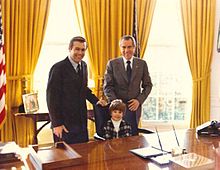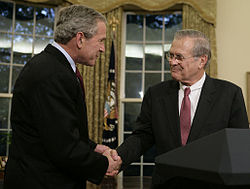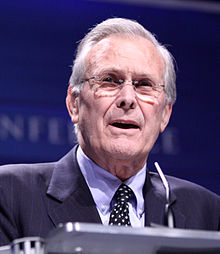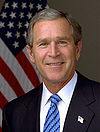- Donald Rumsfeld
-
Donald Rumsfeld 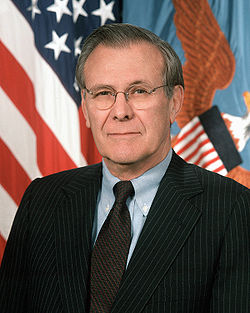
13th and 21st United States Secretary of Defense In office
January 20, 2001 – December 18, 2006President George W. Bush Deputy Paul Wolfowitz (2001-2005)
Gordon R. England (2005-2006)Preceded by William Cohen Succeeded by Robert Gates In office
November 20, 1975 – January 20, 1977President Gerald Ford Deputy Bill Clements Preceded by James R. Schlesinger Succeeded by Harold Brown 6th White House Chief of Staff In office
September 1974 – November 1975President Gerald Ford Preceded by Alexander Haig Succeeded by Dick Cheney 9th United States Permanent Representative to NATO In office
February 1973 – September 1974President Richard Nixon, Gerald Ford Preceded by David M. Kennedy Succeeded by David K.E. Bruce Member of the U.S. House of Representatives
from Illinois's 13th Congressional districtIn office
January 3, 1963 – March 20, 1969Preceded by Marguerite S. Church Succeeded by Phil Crane Personal details Born Donald Henry Rumsfeld
July 9, 1932
Evanston, Illinois, U.S.Political party Republican Spouse(s) Joyce H. Pierson Children Valerie J. Rumsfeld Richard
Marcy K. Rumsfeld Walczak
Donald Nicholas RumsfeldAlma mater Princeton University Religion Presbyterian Signature 
Website The Rumsfeld Papers[1] Military service Service/branch United States Navy Years of service 1954–1975 Rank  Captain
CaptainUnit Navy Reserve (1957–1975)
Individual Ready Reserve (1975–1989)Donald Henry Rumsfeld (born July 9, 1932) is an American politician and businessman. Rumsfeld served as the 13th Secretary of Defense from 1975 to 1977 under President Gerald Ford, and as the 21st Secretary of Defense from 2001 to 2006 under President George W. Bush. He is both the youngest and the oldest person to have served as Secretary of Defense. Additionally, Rumsfeld was a four-term U.S. Congressman from Illinois (1962-1969), Director of the Office of Economic Opportunity (1969-1971), Counsellor to the President (1969-1973), the United States Permanent Representative to NATO (1973-1974), and White House Chief of Staff (1974-1975).
Born in Illinois, Rumsfeld attended Princeton University, graduating in 1954 with a degree in political science. After serving in the Navy for three years, he mounted a campaign for Congress in Illinois' 13th Congressional District, winning in 1962 at the age of 30. Reelected four times, he was a leading co-sponsor of the Freedom of Information Act. Rumsfeld was reluctantly appointed by President Richard Nixon to head the Office of Economic Opportunity in 1969; appointed Counselor by Nixon and entitled to Cabinet-level status, he would also head up the Economic Stabilization Program before being appointed Ambassador to NATO. Called back to Washington in August 1974, Rumsfeld was appointed Chief of Staff by President Ford, recruiting a young one-time staffer of his, Dick Cheney, to succeed him when Ford nominated Rumsfeld Secretary of Defense in 1975.
When Ford lost the 1976 election, Rumsfeld returned to private business life, and was named president of G. D. Searle & Company, a noted pharmaceutical company, during which time he led the legalization of Aspartame. He was later named CEO of General Instrument from 1990 to 1993, and chairman of Gilead Sciences from 1997 to 2001.
Rumsfeld was recommended for the position of Defense Secretary by incoming Vice President Dick Cheney in late 2000, and was appointed in January 2001 by President George W. Bush. His tenure has been noted to be one of the most pivotal in recent history; as one of the key individuals responsible for the restructuring of the military in the new 21st century, Rumsfeld was crucial in planning the United States' response to the September 11, 2001 attacks, which included two wars in Afghanistan and Iraq. Highly popular with the media for his outspokenness and candor, he gradually lost political support as the wars continued and resigned in late 2006.
Contents
Early life
Donald Henry Rumsfeld was born on July 9, 1932, in Evanston, Illinois, to George Donald Rumsfeld and Jeannette (née Huster). His father came from a Swiss American family that had emigrated in the 1870s, and young Donald was sometimes ribbed about looking like a "tough Swiss".[2] Growing up in Winnetka, Illinois, Rumsfeld became an Eagle Scout in 1949 and is the recipient of both the Distinguished Eagle Scout Award from the Boy Scouts of America[3] and its Silver Buffalo Award in 2006. He was a camp counselor at the Northeast Illinois Council's Camp Ma-Ka-Ja-Wan in the late 1940s and a ranger at Philmont Scout Ranch in 1949.[4]
Rumsfeld attended Baker Demonstration School, a private middle school, and later graduated[5] from New Trier High School. He attended Princeton University on academic and NROTC partial scholarships (A.B., 1954). During his time at Princeton, he gained notoriety as an accomplished amateur wrestler, becoming captain of the wrestling team, and captain of the Lightweight Football team playing defensive back. His Princeton University senior thesis was titled "The Steel Seizure Case of 1952 and Its Effects on Presidential Powers."[6] While at Princeton he roomed with another future Secretary of Defense, Frank Carlucci.
Rumsfeld married his high school sweetheart Joyce H. Pierson on December 27, 1954. They have three children and six grandchildren. He toyed with the idea of getting his law degree in 1956, and attended Georgetown University Law Center, but he did not graduate.
Rumsfeld served in the United States Navy during peacetime, from 1954 to 1957, as a naval aviator and flight instructor. His initial training was in the North American SNJ Texan basic trainer after which he transitioned to flying the Grumman F9F Panther fighter. In 1957, he transferred to the Naval Reserve and continued his naval service in flying and administrative assignments as a drilling reservist. On 1 July 1958, he was assigned to Anti-submarine Squadron 662 at Naval Air Station Anacostia, District of Columbia, as a selective reservist.[7] Rumsfeld was designated aircraft commander of Anti-submarine Squadron 731 on 1 October 1960, at Naval Air Station Grosse Ile, Michigan, where he flew the S2F Tracker.[7] He transferred to the Individual Ready Reserve when he became Secretary of Defense in 1975 and retired with the rank of captain in 1989.[8]
Career in government (1962-1977)
Member of Congress
In 1957, during the Dwight D. Eisenhower administration, Rumsfeld served as Administrative Assistant to David S. Dennison, Jr., a Congressman representing the 11th district of Ohio. In 1959, he moved on to become a staff assistant to Congressman Robert P. Griffin of Michigan.[9] Engaging in a two-year stint with an investment banking firm, A. G. Becker, from 1960 to 1962,[10] Rumsfeld would instead set his sights on becoming a member of Congress.
He was elected to the United States House of Representatives for Illinois' 13th congressional district in 1962, at the age of 30, and was re-elected by large majorities in 1964, 1966, and 1968.[11] While in Congress, he served on the Joint Economic Committee, the Committee on Science and Aeronautics, and the Government Operations Committee, as well as on the Subcommittees on Military and Foreign Operations. He was also a co-founder of the Japanese-American Inter-Parliamentary Council[12] in addition to being a leading cosponsor of the Freedom of Information Act.[13]
As a young Congressman, Rumsfeld attended seminars at the University of Chicago, an experience he credits with introducing him to the idea of an all volunteer military, and to the economist Milton Friedman and the Chicago School of Economics.[14] He would later take part in Friedman's PBS series Free to Choose.[15]
Nixon Administration
Rumsfeld resigned from Congress in 1969 — his fourth term — to serve President Richard Nixon in his administration, and he would serve in a variety of executive branch positions throughout the Nixon presidency. In 1969, Nixon sought to reform and reorganize the United States Office of Economic Opportunity, an organization created during the Kennedy administration and greatly expanded as a part of Lyndon Johnson's Great Society programs, rather than eliminate it outright. He appointed Rumsfeld Director of the organization. Rumsfeld had voted against the creation of OEO when he was in Congress, and initially rejected president's offer, citing his own inherent belief that the OEO did more harm than good, and he felt that he was not the right person for the job.[16] He only accepted after a personal plea from the president.
While Director of OEO, Rumsfeld sought to reorganize OEO to serve as "a laboratory for experimental programs."[17] Several beneficial anti-poverty programs were saved by allocated funds to them from other less-successful government programs. During this time, he hired Frank Carlucci and Dick Cheney to serve under him.
He was the subject of one of legendary writer Jack Anderson's columns, alleging that "anti-poverty czar" Rumsfeld had cut programs to aid the poor while spending thousands to redecorate his office. Rumsfeld dictated a four page response to Anderson, labeling the accusations as falsehoods, and invited Anderson to tour his office. Despite the tour, Anderson did not retract his claims, and would only later admit that his column was a mistake.[17]
When he left OEO in December 1970, President Nixon named Rumsfeld Counsellor to the President, a general advisory position that earned him Cabinet-status.[18] He was given an office in the West Wing and now regularly interacted with the Nixon administration hierarchy. He was named Director of the Economic Stabilization Program in 1970 as well, and headed up the Cost of Living Council. In 1971 Nixon was recorded saying about Rumsfeld "at least Rummy is tough enough" and "He's a ruthless little bastard. You can be sure of that."[19][20][21][22][23]
In February 1973, Rumsfeld left Washington to serve as U.S. Ambassador to the North Atlantic Treaty Organization (NATO) in Brussels, Belgium. He served as the United States' Permanent Representative to the North Atlantic Council and the Defense Planning Committee, and the Nuclear Planning Group. In this capacity, he represented the United States in wide-ranging military and diplomatic matters, and was asked to help mediate a conflict on behalf of the United States between Cyprus and Turkey.[24]
Ford Administration
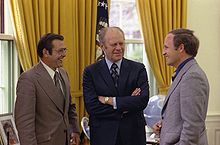 Secretary of Defense Rumsfeld (left) and White House Chief of Staff Dick Cheney (right) meet with President Gerald Ford, April 1975
Secretary of Defense Rumsfeld (left) and White House Chief of Staff Dick Cheney (right) meet with President Gerald Ford, April 1975
In August 1974, Rumsfeld was called back to Washington to serve as transition chairman for the new president, Gerald R. Ford. He had been Ford's confidant since their days in the House when Ford was House minority leader. As the new president became settled in, Ford appointed Rumsfeld White House Chief of Staff, where he served from 1974 to 1975.
In October 1975, Ford reshuffled his cabinet in the Halloween Massacre. He named Rumsfeld to become the 13th U.S. Secretary of Defense; George H. W. Bush became Director of Central Intelligence. According to Bob Woodward's 2002 book Bush at War, a rivalry developed between the two men and "Bush senior was convinced that Rumsfeld was pushing him out to the CIA to end his political career."[25]
At the Pentagon, Rumsfeld oversaw the transition to an all-volunteer military. He sought to reverse the gradual decline in the defense budget and to build up U.S. strategic and conventional forces, skillfully undermining Secretary of State Henry Kissinger at the SALT talks.[26] He asserted, along with Team B (which he helped to set up),[27] that trends in comparative U.S.-Soviet military strength had not favored the United States for 15 to 20 years and that, if continued, they "would have the effect of injecting a fundamental instability in the world."[8] For this reason, he oversaw the development of cruise missiles, the B-1 bomber, and a major naval shipbuilding program.[26]
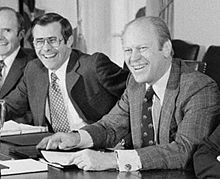 Secretary Rumsfeld (left), seated at the Cabinet table, laughing with President Gerald Ford in 1975.
Secretary Rumsfeld (left), seated at the Cabinet table, laughing with President Gerald Ford in 1975.
In 1977, Rumsfeld was awarded the nation's highest civilian award, the Presidential Medal of Freedom.[28]
Kissinger, his bureaucratic adversary, would later pay him a different sort of compliment, pronouncing him
a special Washington phenomenon: the skilled full-time politician-bureaucrat in whom ambition, ability, and substance fuse seamlessly.Return to the private sector (1977–2000)
Business career
In early 1977 Rumsfeld briefly lectured at Princeton's Woodrow Wilson School and Northwestern's Kellogg School of Management, located in Chicago, Illinois near his home town of Evanston. His sights instead turned to business, and from 1977 to 1985 Rumsfeld served as Chief Executive Officer, President, and then Chairman of G. D. Searle & Company, a worldwide pharmaceutical company based in Skokie, Illinois. During his tenure at Searle, Rumsfeld led the company's financial turnaround, thereby earning awards as the Outstanding Chief Executive Officer in the Pharmaceutical Industry from the Wall Street Transcript (1980) and Financial World (1981). In 1985, Searle was sold to Monsanto Company. Rumsfeld is believed to have earned around $12 million from this sale.[30]
Rumsfeld served as Chairman and Chief Executive Officer of General Instrument Corporation from 1990 to 1993. A leader in broadband transmission, distribution, and access control technologies for cable, satellite and terrestrial broadcasting applications, the company pioneered the development of the first all-digital high-definition television (HDTV) technology. After taking the company public and returning it to profitability, Rumsfeld returned to private business in late 1993.
From January 1997 until being sworn in as the 21st Secretary of Defense in January 2001, Rumsfeld served as Chairman of Gilead Sciences, Inc. Gilead Sciences is the developer of Tamiflu (Oseltamivir), which is used in the treatment of bird flu.[31] As a result, Rumsfeld's holdings in the company grew significantly when avian flu became a subject of popular anxiety during his later term as Secretary of Defense. Following standard practice, Rumsfeld recused himself from any decisions involving Gilead, and he directed the Pentagon's General Counsel to issue instructions outlining what he could and could not be involved in if there were an avian flu pandemic and the Pentagon had to respond.[32][33][34]
Part-time public service
as President Reagan's Special Envoy to the Middle East, Rumsfeld met with Saddam Hussein during a visit to Baghdad in December 1983, during the Iran–Iraq War
During his business career, Rumsfeld continued part-time public service in various posts. In November 1983, Rumsfeld was appointed Special Envoy to the Middle East by President Ronald Reagan, at a turbulent time in modern Middle Eastern history when Iraq was fighting Iran in the Iran–Iraq War. The United States wished for the conflict to end, and Rumsfeld was sent to the Middle East to serve as a mediator on behalf of the President.
When Rumsfeld visited Baghdad on December 20, 1983, he met Saddam Hussein at Saddam's palace and had a 90-minute discussion. They largely agreed on opposing Syria's occupation of Lebanon; preventing Syrian and Iranian expansion; and preventing arms sales to Iran. Rumsfeld suggested that if U.S.-Iraq relations could improve the U.S. might support a new oil pipeline across Jordan, which Iraq had opposed but was now willing to reconsider. Rumsfeld also informed Iraqi Deputy Prime Minister and Foreign Minister Tariq Aziz that "Our efforts to assist were inhibited by certain things that made it difficult for us ... citing the use of chemical weapons."[35]
Rumsfeld wrote in his memoir Known and Unknown that his meeting with Hussein "has been the subject of gossip, rumors, and crackpot conspiracy theories for more than a quarter of a century... Supposedly I had been sent to see Saddam by President Reagan either to negotiate a secret oil deal, to help arm Iraq, or to make Iraq and American client state. The truth is that our encounter was more straightforward and less dramatic."[36]
In addition to taking the position of Middle East envoy, Rumsfeld served as a member of the President's General Advisory Committee on Arms Control (1982–1986); President Reagan's Special Envoy on the Law of the Sea Treaty (1982–1983); a senior adviser to President Reagan's Panel on Strategic Systems (1983–1984); a member of the Joint Advisory Commission on U.S./Japan Relations (1983–1984); a member of the National Commission on the Public Service (1987–1990); a member of the National Economic Commission (1988–1989); a member of the Board of Visitors of the National Defense University (1988–1992); a member of the FCC's High Definition Television Advisory Committee (1992–1993); a member of the U.S. Trade Deficit Review Commission (1999–2000); a member of the Council on Foreign Relations; and Chairman of the U.S. Commission to Assess National Security Space Management and Organization (2000). Among his most noteworthy positions was Chairman of the nine-member Commission to Assess the Ballistic Missile Threat to the United States from January to July 1998. In its findings, the commission concluded that Iraq, Iran, and North Korea could develop intercontinental ballistic missile capabilities in five to ten years and that U.S. intelligence would have little warning before such systems were deployed.[37]
During the 1980s, Rumsfeld became a member of the National Academy of Public Administration, and was named a member of the boards of trustees of the Gerald R. Ford Foundation, the Eisenhower Exchange Fellowships, the Hoover Institution at Stanford University and the National Park Foundation. He was also a member of the U.S./Russia Business Forum and Chairman of the Congressional Leadership's National Security Advisory Group.[citation needed] Rumsfeld was a founder and active member of the Project for the New American Century, a neo-conservative think-tank dedicated to maintaining U.S. primacy. In addition, he served as United Way Inter-governmental Affairs Director in Washington, D.C. from 1986 to 1989 and was asked to serve the U.S. State Department as a foreign policy consultant from 1990 to 1993. He also sat on European Engineering giant Asea Brown Boveri's board from 1990 to 2001, a company which sold two light-water nuclear reactors to the Korean Peninsula Energy Development Organization for installation in North Korea, as part of the 1994 agreed framework reached under President Bill Clinton. Rumsfeld's office said that he did not "recall it being brought before the board at any time" though Fortune magazine reported that "board members were informed about this project."[38]
To honor his foreign policy work, Rumsfeld was named honorary Vice-Chancellor of Yale University in 2001.[citation needed]
Presidential and vice presidential aspirations
During 1976 Republican National Convention, Rumsfeld received one vote for Vice President of the United States, although he did not seek the office, and the nomination was easily won by Ford's choice, Senator Bob Dole.[39] During the 1980 Republican National Convention he also received one vote for Vice President.[40] Economist Milton Friedman later noted that he, Friedman, regarded Reagan's pick of Bush as "the worst decision not only of his campaign but of his presidency," and that Rumsfeld was instead his preference. "Had he been chosen," Friedman said, "I believe he would have succeeded Reagan as president and the sorry Bush-Clinton period would never have occurred."[41]
Rumsfeld briefly sought the Presidential nomination in 1988, but withdrew from the race before primaries began.[42] During the 1996 election he initially formed a presidential exploratory committee, but declined to formally enter the race. He was instead named national chairman for Republican nominee Bob Dole's campaign.[43]
Return to government (2001–2006)
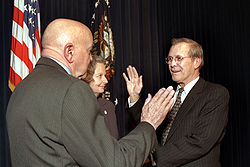 Rumsfeld is administered the oath of office as the 21st Secretary of Defense on January 20, 2001 by Director of Administration and Management David O. Cooke (left), as Joyce Rumsfeld holds the Bible in a ceremony at the Eisenhower Executive Office Building
Rumsfeld is administered the oath of office as the 21st Secretary of Defense on January 20, 2001 by Director of Administration and Management David O. Cooke (left), as Joyce Rumsfeld holds the Bible in a ceremony at the Eisenhower Executive Office Building
Rumsfeld was named Secretary of Defense soon after President George W. Bush took office in 2001. Bush's first choice, FedEx founder Fred Smith, was unavailable and Vice President-elect Cheney recommended Rumsfeld for the job.[44]
Rumsfeld's second tenure as Secretary of Defense cemented him as the most powerful Pentagon chief since Robert McNamara and one of the most influential Cabinet members in the Bush administration.[45] His tenure would prove to be a pivotal and rocky one which led the United States military into the 21st century. Following the September 11, 2001 attacks, Rumsfeld led the military planning and execution of the U.S. invasion of Afghanistan and the subsequent 2003 invasion of Iraq. He pushed hard to send as small a force as possible to both conflicts, a concept codified as the Rumsfeld Doctrine.
Throughout his time as Defense Secretary, Rumsfeld was noted for his candor and quick wit when giving weekly press conferences or speaking with the press.[46] U.S. News & World Report called him "a straight-talking Midwesterner" who "routinely has the press corps doubled over in fits of laughter."[46]
Modernizing the military
Rumsfeld's initial task, as outlined by President Bush, was to modernize the military and transform it into a lighter fighting force. Once in office, Rumsfeld immediately announced a series of sweeping reviews intended to accomplish this, and developed a new strategy for defense more relevant to the 21st century. Central to his proposal was to reorganize the global command structure, otherwise known as the Unified Command, replacing it with both the U.S. Strategic Command and Northern Command systems. Strategic Command would take over responsibilities that were held by the Strategic Command and Space Command, both of which were disestablished. This plan was approved by President Bush and implemented under the oversight of Rumsfeld.[8]
September 11, 2001
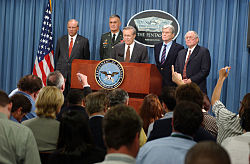 "The Pentagon is functioning" was the message Rumsfeld stressed during a press conference in the Pentagon briefing room barely eight hours after terrorists crashed a hijacked commercial jetliner into the Pentagon. Rumsfeld is flanked, left to right, by Secretary of the Army Tom White, Chairman of the Joint Chiefs of Staff General Hugh Shelton, and Senators John Warner (R-VA), and Carl Levin (D-MI), the Ranking Member and Chairman of the Senate Armed Services Committee.
"The Pentagon is functioning" was the message Rumsfeld stressed during a press conference in the Pentagon briefing room barely eight hours after terrorists crashed a hijacked commercial jetliner into the Pentagon. Rumsfeld is flanked, left to right, by Secretary of the Army Tom White, Chairman of the Joint Chiefs of Staff General Hugh Shelton, and Senators John Warner (R-VA), and Carl Levin (D-MI), the Ranking Member and Chairman of the Senate Armed Services Committee.
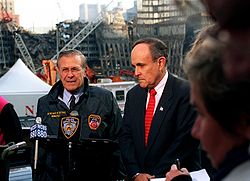 Rumsfeld and New York Mayor Rudy Giuliani speak at the site of the World Trade Center attacks in Lower Manhattan on November 14, 2001
Rumsfeld and New York Mayor Rudy Giuliani speak at the site of the World Trade Center attacks in Lower Manhattan on November 14, 2001
The United States was attacked on September 11, 2001 by al Qaeda terrorists who hijacked commercial airliners and crashed them in coordinated strikes into both towers of the World Trade Center in Lower Manhattan, New York City and the Pentagon in Washington, D.C. The fourth plane crashed into a field in Shanksville, Pennsylvania, and its target was likely a prominent building in Washington, D.C., most probably either the Capitol Building or the White House.[47] Within three hours of the start of the first hijacking and two hours after American Airlines Flight 11 struck the World Trade Center, Rumsfeld raised the defense condition signaling of the United States offensive readiness to DEFCON 3, the highest it had been since the Arab-Israeli war in 1973.[48]
On the morning of 9/11, Rumsfeld spoke at a Pentagon breakfast meeting. According to his later description to Larry King, he stated at the meeting that "sometime in the next two, four, six, eight, ten, twelve months there would be an event that would occur in the world that would be sufficiently shocking that it would remind people again how important it is to have a strong healthy defense department that contributes to... that underpins peace and stability in our world. And that is what underpins peace and stability."[49]
After the strike on the Pentagon by American Airlines Flight 77, Rumsfeld went out to the parking lot to assist with rescue efforts.[50] He later recalled that "I wanted to see what had happened. I wanted to see if people needed help. I went downstairs and helped for a bit with some people on stretchers. Then I came back up here and started — I realized I had to get back up here and get at it."[49]
Military decisions in the wake of 9/11
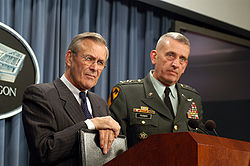 Secretary of Defense Donald H. Rumsfeld (left) and the Commander of U.S. Central Command General Tommy Franks, listen to a question at the close of a Pentagon press conference on March 5, 2003. Rumsfeld and Franks gave reporters an operational update and fielded questions on the possible conflict in Iraq.
Secretary of Defense Donald H. Rumsfeld (left) and the Commander of U.S. Central Command General Tommy Franks, listen to a question at the close of a Pentagon press conference on March 5, 2003. Rumsfeld and Franks gave reporters an operational update and fielded questions on the possible conflict in Iraq.
On the afternoon of September 11, Rumsfeld issued rapid orders to his aides to look for evidence of possible Iraqi involvement in regard to what had just occurred, according to notes taken by senior policy official Stephen Cambone. "Best info fast. Judge whether good enough hit S.H." — meaning Saddam Hussein — "at same time. Not only UBL" (Osama bin Laden), Cambone's notes quoted Rumsfeld as saying. "Need to move swiftly — Near term target needs — go massive — sweep it all up. Things related and not."[51][52]
That evening, after President Bush spoke to the nation from the Oval Office, Rumsfeld recalled musing about the President's intended response to attack terrorists from whatever territory they planned and operated. He reported questioning whether that would include attacking American allies, and suggested that the problem be magnified and viewed from a broader scope. He recommended that state-sponsors of terror, including Sudan, Libya, Iraq and Iran, be considered as possible places of sanctuary if the U.S. were attack Afghanistan.[53]
Rumsfeld wrote in Known and Unknown, "Much has been written about the Bush administration's focus on Iraq after 9/11. Commentators have suggested that it was strange or obsessive for the President and his advisers to have raised questions about whether Saddam Hussein was somehow behind the attack. I have never understood the controversy. I had no idea if Iraq was or was not involved, but it would have been irresponsible for any administration not to have asked the question."[54]
"Looking back on the weeks following 9/11," he wrote, "Some accounts suggest an administration that seemed to have a preordained response to the attacks. From my vantage point, however, quite the opposite was the case. It was a time of discovery–of seeking elusive, imperfect solutions for new problems that would not be solved quickly. There was no guidebook or road map for us to follow."[55]
Afghanistan and Iraq
After the war in Afghanistan was launched, Rumsfeld participated in a meeting in regard to the review of the Department of Defense's Contingency Plan in the event of a war with Iraq. The plan, as it was then conceived, contemplated troop levels of up to 500,000, which Rumsfeld felt was far too many. Gordon and Trainor wrote:
As [General] Newbold outlined the plan ... it was clear that Rumsfeld was growing increasingly irritated. For Rumsfeld, the plan required too many troops and supplies and took far too long to execute. It was, Rumsfeld declared, the "product of old thinking and the embodiment of everything that was wrong with the military."[56]Rumsfeld's plan resulted in a lightning invasion that took Baghdad in well under a month with very few American casualties. Many government buildings, plus major museums, electrical generation infrastructure, and even oil equipment were looted and vandalized during the transition from the fall of Saddam Hussein's regime to the establishment of the Coalition Provisional Authority. A violent insurrection began shortly after the military operation started. After the German and French governments voiced opposition to invading Iraq, Rumsfeld labeled these countries as part of "Old Europe", implying that countries that supported the war were part of a newer, modern Europe.[57]
As a result, Rumsfeld stirred controversy as to whether the forces that did invade Iraq were enough in size.[56] In a September 2007 interview with The Daily Telegraph, General Mike Jackson, the head of the British army during the invasion, criticized Rumsfeld's plans for the invasion of Iraq as "intellectually bankrupt," adding that Rumsfeld is "one of those most responsible for the current situation in Iraq," and that he felt that "the US approach to combating global terrorism is 'inadequate' and too focused on military might rather than nation building and diplomacy." [58]
In 2006, Rumsfeld responded to a question by Brit Hume of Fox News as to whether he pressed General Tommy Franks to lower his request for 400,000 troops for the war:
Absolutely not. That's a mythology [sic]. This town [Washington, D.C] is filled with this kind of nonsense. The people who decide the levels of forces on the ground are not the Secretary of Defense or the President. We hear recommendations, but the recommendations are made by the combatant commanders and by members of the Joint Chiefs of Staff and there hasn't been a minute in the last six years when we have not had the number of troops that the combatant commanders have requested.[59]Rumsfeld told Hume that Franks ultimately decided against such a troop level.[60]
There was also controversy between Rumsfeld at the Pentagon and the CIA over who had the authority to fire Hellfire missiles from Predator drones.[61] Even though the drones were not ready for delpyment until 2002,[61] Daniel Benjamin and Steven Simon have argued that "these quarrels kept the Predator from being used against al Qaeda.... One individual who was at the center of the action called this episode 'typical' and complained that 'Rumsfeld never missed an opportunity to fail to cooperate. The fact is, the Secretary of Defense is an obstacle. He has helped the terrorists.'[62]
After the Iraq invasion, U.S. troops were criticized for not protecting the historical artifacts and treasures located at the National Museum of Iraq. When asked at the time why U.S. troops did not actively seek to stop the lawlessness, Rumsfeld replied, "Stuff happens... and it's untidy and freedom's untidy, and free people are free to make mistakes and commit crimes and do bad things. They're also free to live their lives and do wonderful things. And that's what's going to happen here." [63] He further commented that, "The images you are seeing on television you are seeing over, and over, and over, and it's the same picture of some person walking out of some building with a vase, and you see it 20 times, and you think, "My goodness, were there that many vases?"[63]
 Secretary Rumsfeld responds to a reporter's question during a Pentagon press briefing. Rumsfeld and General Richard Myers, Chairman of the Joint Chiefs of Staff, gave reporters an operational update on Operation Iraqi Freedom on October 2, 2003.
Secretary Rumsfeld responds to a reporter's question during a Pentagon press briefing. Rumsfeld and General Richard Myers, Chairman of the Joint Chiefs of Staff, gave reporters an operational update on Operation Iraqi Freedom on October 2, 2003.
Throughout his tenure, Rumsfeld sought to remind the American people of the 9/11 attacks and threats against Americans, noting at one time in a 2006 memo to "[m]ake the American people realize they are surrounded in the world by violent extremists."[64][65]
As Secretary of Defense, Rumsfeld was deliberate in crafting the public message from the Department of Defense. People will "rally" to the word "sacrifice", Rumsfeld noted after a meeting. "They are looking for leadership. Sacrifice = Victory." In May 2004, Rumsfeld considered whether to redefine the war on terrorism as a fight against "worldwide insurgency." He advised aides "to test what the results could be" if the war on terrorism were renamed.[65] Rumsfeld also ordered specific public Pentagon attacks on and responses to U.S. newspaper columns that reported the negative aspects of the war, which he often personally reviewed before they were sent.[65]
In October 2003, Rumsfeld personally approved a secret Pentagon "roadmap" on public relations, calling for "boundaries" between information operations abroad and the news media at home. The Roadmap advances a policy according to which as long as the U.S. government does not intentionally target the American public, it does not matter that psychological operations, reach the American public.[66]
Prisoner abuse and enhanced interrogation techniques
The Department of Defense's preliminary concerns for holding, housing, and interrogating captured prisoners on the battlefield were raised during the military build-up prior to the Iraq War. Because Saddam Hussein’s military forces surrendered when faced with military action, many within the DOD, including Rumsfeld and United States Central Command General Tommy Franks, decided it was in the best interest of all to hand these prisoners over to their respective countries. Additionally, it was determined that maintaining a large holding facility was, at the time, unrealistic. Instead, the use of many facilities such as Abu Ghraib would be utilized to house prisoners prior to handing them over and Rumsfeld defended the Bush administration's decision to detain enemy combatants without protection under the Third Geneva Convention. Because of this, critics, including the U.S. Senate Armed Services Committee, would hold Rumsfeld responsible for the ensuing Abu Ghraib torture and prisoner abuse scandal. Rumsfeld himself said: "These events occurred on my watch as Secretary of Defense. I am accountable for them." [67] He offered his resignation to President Bush in the wake of the scandal, but it was not accepted.[68]
 Rumsfeld, center, gestures to make a point as he answers a Senator’s question during a Senate Armed Services Committee hearing in the Hart Senate Office Building in Washington, D.C. Chairman of the Joint Chiefs of Staff Gen. Richard B. Myers, and Under Secretary of Defense (Comptroller) Tina Jonas joined the Secretary in testifying before the committee.
Rumsfeld, center, gestures to make a point as he answers a Senator’s question during a Senate Armed Services Committee hearing in the Hart Senate Office Building in Washington, D.C. Chairman of the Joint Chiefs of Staff Gen. Richard B. Myers, and Under Secretary of Defense (Comptroller) Tina Jonas joined the Secretary in testifying before the committee.
In a memo read by Rumsfeld detailing how Guantanamo interrogators would induce stress in prisoners by forcing them to remain standing in one position for a maximum of four hours, Rumsfeld scrawled a handwritten note in the margin reading: "I stand for 8-10 hours a day. Why is standing [by prisoners] limited to four hours? D.R.".[69]
Various organizations, such as Human Rights Watch, have called for investigations of Rumsfeld regarding his involvement in managing the Iraq War and his support of the Bush administration's policies of enhanced interrogation techniques.[70][71] In 2005 the ACLU and Human Rights First filed a lawsuit against Rumsfeld and other top government officials, "on behalf of eight men who they say were subjected to torture and abuse by U.S. forces under the command of Defense Secretary Donald Rumsfeld."[72] In 2005, a suit was filed against Rumsfeld by several human rights organizations for allegedly violating U.S. and international law that prohibits "torture and cruel, inhuman, or degrading punishment."[72] Donald Vance and Nathan Ertel filed suit against the U.S. government and Rumsfeld on similar grounds, alleging that they were tortured and their rights of habeas corpus were violated.[73][74][75][76][77][78] In 2007, U.S. District Judge Thomas F. Hogan ruled that Rumsfeld could not "be held personally responsible for actions taken in connection with his government job."[79] The ACLU tried to revive the case in 2011 with no luck.[80]
Resignation
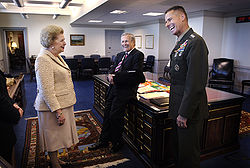 Rumsfeld with former British Prime Minister Margaret Thatcher alongside the Chairman of the Joint Chiefs of Staff General Peter Pace.
Rumsfeld with former British Prime Minister Margaret Thatcher alongside the Chairman of the Joint Chiefs of Staff General Peter Pace.
Eight retired generals and admirals called for Rumsfeld to resign in early 2006 in what was called the "Generals Revolt," accusing him of "abysmal" military planning and lack of strategic competence.[81][82][83] Commentator Pat Buchanan reported at the time that Washington Post columnist David Ignatius, who traveled often to Iraq and supported the war, claimed that the generals' and admirals' views mirror those of 75 percent of the officers in the field, and probably more."[84] Rumsfeld rebuffed these criticisms, stating that "out of thousands and thousands of admirals and generals, if every time two or three people disagreed we changed the secretary of defense of the United States, it would be like a merry-go-round."[85] Bush defended his secretary throughout, and responded by stating that Rumsfeld is "exactly what is needed".[86]
On November 1, 2006, Bush stated he would stand by Rumsfeld as defense secretary for the length of his term as president.[87] Rumsfeld wrote a resignation letter dated November 6, and, per the stamp on the letter, Bush saw it on Election Day, November 7.[88] In the elections, the House and the Senate shifted to Democratic control. After the elections, on November 8, Bush announced Rumsfeld would resign his position as Secretary of Defense. Many Republicans were unhappy with the delay, believing they would have won more votes if voters had known Rumsfeld was resigning.[88]
Bush nominated Robert Gates to succeed Rumsfeld[89][90][91] and at a press conference announcing Rumsfeld's resignation and Gates' nomination, Bush remarked, "America is safer and the world is more secure because of the service and the leadership of Donald Rumsfeld."[92]
On December 18, 2006, Rumsfeld's resignation took effect. One of his last actions as defense secretary was to pay a surprise visit to Iraq on December 10, 2006, to bid farewell to the United States military serving there.[93] In a farewell ceremony on December 16, 2006, Rumsfeld's long-time political ally Vice President Dick Cheney, who worked with him in the Ford administration and who also had served as a secretary of defense, called the secretary "the finest secretary of defense this nation has ever had."
Including his time serving as the 13th Secretary of Defense under Ford from 1975 to 1977, Rumsfeld is the second-longest-serving Secretary of Defense in history, falling nine days short of the term of the longest-serving Pentagon chief, the Vietnam-era Secretary of Defense, Robert McNamara.
Retirement and later life (2006–present)
In the months after his resignation, Rumsfeld toured the New York publishing houses in preparation for a potential memoir.[94] After receiving what one industry source labeled "big bids", he reached an agreement with the Penguin Group to publish the book under its Sentinel HC imprint.
In 2007, Rumsfeld established The Rumsfeld Foundation, an educational foundation that provides fellowships to talented individuals from the private sector who want to serve for some time in government.[95] Rumsfeld personally financed the foundation.[96] The foundation has granted over 50 fellowships to graduate students from Central Asia, provided over $2.1 million in microfinance grants, and donated over $200,000 to charities for veterans affairs.[95]
In September 2007, Rumsfeld received a one-year appointment as a Distinguished Visiting Fellow at the Hoover Institution at Stanford University,[97] joining (among others) retired Army Gen. John P. Abizaid, former commander of U.S. Central Command, and fellow conservatives George Shultz and Newt Gingrich. He participated in the institution's new task force studying post–September 11 ideology and non-state terror.[citation needed]
Rumsfeld declined to accept an advance for the publication of his memoir, and has said he is donating any proceeds from the work to veterans groups.[95] His book, entitled Known and Unknown: A Memoir, was released on February 8, 2011.[98]
In conjunction with the publication of Known and Unknown, Rumsfeld established "The Rumsfeld Papers", a website with documents "related to the endnotes" of the book and his service during the George W. Bush administration;[1] during the months that followed the book's publication, the website is being expanded to include "a number of other documents from [his] archive"; as of June 2011, the topics include his Congressional voting record, the Nixon administration, documents and memos of meetings while he was part of the Ford administration, private sector documents, and NATO documents, among others.[1]
Rumsfeld was awarded the "Defender of the Constitution Award" at the 2011 Conservative Political Action Conference in Washington, D.C., on February 10, 2011. After leaving office, Rumsfeld repeatedly criticized former fellow Cabinet member Condoleezza Rice, Secretary of State. In 2011 she finally responded, saying that Rumsfeld "doesn't know what he's talking about."[99]
Electoral history
Main article: Electoral history of Donald RumsfeldDuring the four elections during which he ran to represent Illinois's 13th congressional district, Rumsfeld received shares of the popular vote that ranged from 57.82% (in 1964) to 76.01% (in 1966). In 1975 and 2001, Rumsfeld was overwhelmingly confirmed by the U.S. Senate after Presidents Gerald Ford and George W. Bush, respectively, appointed him as U.S. Secretary of Defense.
Awards
Rumsfeld has been awarded 11 honorary degrees.[citation needed] Following his years as CEO, President, and later Chairman of G. D. Searle & Company, he was recognized as Outstanding CEO in the pharmaceutical industry by the Wall Street Transcript (1980) and Financial World (1981).[citation needed]
His other awards include:
- The Presidential Medal of Freedom by President Ford (1977)
- Royal Order of the Intare by King Kigeli V of Rwanda
- George C. Marshall Medal by the U.S. Army Association (1984)
- Woodrow Wilson Medal by Princeton University (1985)
- Dwight D. Eisenhower Medal (1993)
- Lone Sailor Award by the U.S. Navy Memorial Foundation (2002)
- Statesmanship Award by the U.S. Assoc of Former Members of Congress (2003)
- James H. Doolittle Award by the Hudson Institute (2003)
- Gerald R. Ford Medal presented by President Ford and the Ford Foundation (2004)[100]
- Distinguished Eagle Scout Award by the Boy Scouts of America
- Union League of Philadelphia Gold Medal for Citizenship (2006)
- Claremont Institute Statesmanship Award (2007)
- Victory of Freedom Award from the Richard Nixon Foundation (2010)[101]
- Order of Anthony Wayne from Valley Forge Military Academy
Affiliation history
Institutional affiliations
- Center for Security Policy: Longtime associate; winner of the CSP's 1998 "Keeper of the Flame" award (5)
- Hoover Institution: Member, board of trustees
- Project for the New American Century: Signed PNAC's founding statement of principles as well as two policy letters on Iraq
- Freedom House: Board member
- RAND Corporation: Board member
- Committee for the Free World: Former chairman
- Bohemian Club: Member
Government posts, panels, and commissions
- Secretary of Defense (2001–06)
- U.S. Commission to Assess National Security Space Management and Organization: Chairman (2000)
- U.S. Ballistic Missile Threat Commission: Chairman (1998)
- Secretary of Defense (1975–77)
- White House Chief of Staff in Ford administration (1974–75)
- U.S. Ambassador to NATO (1973–74)
- U.S. Congress: Representative from Illinois (1962–69)
- United States Navy: Various posts, including aviator (1954–57); reserves (1957–1975) Retired as a Navy Captain (1989)
Corporate connections and business interests
- Gilead Sciences: joined Gilead as a director in 1988 Chairman (1997–2001)
- General Instrument Corporation: Chairman and CEO (1990–93)
- G.D. Searle pharmaceutical company: CEO/Chairman/President (1977–1985)
- Bechtel Corporation: Was involved in Iraq-Bechtel negotiations in the 1980s on a pipeline project
- Gulfstream Aerospace: Former director
- Tribune Company: Former director
- Metricom, Inc.: Former director
- Sears, Roebuck and Co.: Former director
- ABB AB: Former director
- Kellogg Company: director 1985–199? while Carlos Gutierrez (x Cuba 1960) president CEO and chairman Kellogg until named Secretary Commerce under Bush from 2005
- RAND Corporation: Chairman of Board from 1981–1986; 1995–1996
- Bilderberg Group: Member[citation needed]
- Amylin Pharmaceuticals: Former director
Education
- Princeton University: A.B. (1954)
Intellectual heritage
See also
- Agathidium rumsfeldi — the naming of a beetle in homage to Rumsfeld
- Hillbilly armor — Rumsfeld questioned by a soldier about the use of "ad hoc" armor
- 'Known knowns' - quotation
- Known and Unknown: A Memoir, Rumsfeld's memoir of his life
Footnotes
- ^ a b c "About the Library". The Rumsfeld Papers. DHR Holdings LLC. http://www.rumsfeld.com/library/page/about-the-library. Retrieved 2011-06-21.
- ^ Bradley Graham, By His Own Rules (2009) pp 16, 31
- ^ Scouting magazine "Speakers Highlight Scouting's Core Values". Scouting 94 (4): 35. http://www.scoutingmagazine.org/issues/0609/a-chrt.html Scouting magazine. September 2006
- ^ Secretary Rumsfeld's Remarks at the White House Conference on Cooperative Conservation — U.S. Department of Defense News Transcript — August 29, 2005
- ^ Habermehl, Kris (2007-01-25). "Fire Breaks Out At Prestigious High School". http://cbs2chicago.com/local/New.Trier.High.2.334860.html. Retrieved 2008-06-28.[dead link]
- ^ Princeton University Senior Theses Full Record: Donald Henry Rumsfeld
- ^ a b http://www.airforcetimes.com/legacy/new/0-AIRPAPER-1610997.php
- ^ a b c DefenseLink's Rumsfeld Biography
- ^ RUMSFELD, Donald Henry on Biographical Directory of the United States Congress. Accessed April 22, 2007.
- ^ Donald Rumsfeld biography from the Associated Press. Accessed April 22, 2007.
- ^ Donald Rumsfeld biography from Whitehouse.gov. Accessed April 22, 2007.
- ^ Donald Rumsfeld biography from White House press release dated November 3, 1975. Accessed April 22, 2007.
- ^ Freedom of Information Act at 40
- ^ "Secretary of Defense Donald H. Rumsfeld speaking at Tribute to Milton Friedman (transcript)". United States Department of Defense. http://www.defenselink.mil/speeches/speech.aspx?speechid=216.
- ^ Free to Choose: Tyranny of Control
- ^ Rumsfeld, Donald (2011), pp. 119-121
- ^ a b Rumsfeld, Donald (2011), p. 125
- ^ Graham, By His Own Rules p 75
- ^ Nixon White House conversation 464-12
- ^ Alexander Cockburn, Rumsfeld: His Rise, Fall, and Catastrophic Legacy, Simon and Schuster, 2007, page 20
- ^ Craig Unger, The Fall of the House of Bush: The Untold Story of how a Band of True Believers Seized the Executive Branch, Started the Iraq War, and Still Imperils America's Future, Simon and Schuster, 2007, page 50
- ^ Craig Unger, American Armageddon: How the Delusions of the Neoconservatives and the Christian Right Triggered the Descent of America--and Still Imperil Our Future, Simon and Schuster, 2008, page 50
- ^ Naomi Klein, The Shock Doctrine: The Rise of Disaster Capitalism, Metropolitan Books/Henry Holt, 2007
- ^ Rumsfeld, Donald (2011), p. 157
- ^ Woodward, Bob (2002). Bush At War. Simon and Schuster. pp. 21–22. ISBN 0743244613. http://books.google.com/?id=BRzVPPstf3EC&pg=PA21&lpg=PA21&dq=rumsfeld+ford+bush+cia+director.
- ^ a b "Defense Choice Made a Name As an Infighter". New York Times. 2001-01-08. http://query.nytimes.com/gst/fullpage.html?res=9406EFD8153AF93BA35752C0A9679C8B63&sec=&spon=&pagewanted=2. Retrieved 2008-08-18.
- ^ The Long March of Dick Cheney
- ^ DefenseLink's Secretary of Defense Biography
- ^ Mann, James (2003-10-08). "Rumsfeld's Roots". The Atlantic. http://www.theatlantic.com/doc/200310u/int2003-10-08. Retrieved 2008-08-18.
- ^ "Winter comes for a Beltway lion; Rumsfeld rose and fell with his conviction intact". Chicago Tribune: p. 17. 2006-11-12.
- ^ Press Releases: Gilead
- ^ Schmit, Julie (November 17, 2005). "Roche, Gilead Sciences resolve Tamiflu conflict". USA Today. http://www.usatoday.com/news/health/2005-11-16-tamiflu-usat_x.htm. Retrieved May 1, 2010.
- ^ Schwartz, Nelson D. (October 31, 2005). "Rumsfeld's growing stake in Tamiflu". CNN. http://money.cnn.com/2005/10/31/news/newsmakers/fortune_rumsfeld/. Retrieved May 1, 2010.
- ^ "Bird Flu: A Corporate Bonanza for the Biotech Industry". GlobalResearch.ca. http://www.globalresearch.ca/index.php?context=viewArticle&code=ENG20051106&articleId=1190. Retrieved 2008-05-24.
- ^ Graham, By His Own Rules (2009) pp 159-60
- ^ Rumsfeld, Donald (2011), p. 6
- ^ Report of the Commission to Assess the Ballistic Missile Threat to the United States
- ^ "Rummy's North Korea Connection; What did Donald Rumsfeld know about ABB's deal to build nuclear reactors there? And why won't he talk about it?". Fortune: p. 75. 2003-05-12.
- ^ OurCampaigns
- ^ OurCampaigns
- ^ "Two Lucky People: Memoirs" by Milton Friedman and Rose Friedman. 1998. (Chicago: University of Chicago Press): p. 391
- ^ OurCampaigns
- ^ "Dole-Kemp Campaign names former Secretary of Defense Donald Rumsfeld as its national chairman," Press Release by Dole-Kemp 1996, August 27, 1996
- ^ Bush, George W. (2010), pp. 83–84
- ^ Moniz, Dave (December 9, 2002). "Rumsfeld's abrasive style sparks conflict". USA Today. http://www.usatoday.com/news/washington/2002-12-09-1a-cover_x.htm. Retrieved 2011-11-17.
- ^ a b Wright, Robert (January 20, 2002). "Rumsfeld's Moment". The New York Times. http://www.nytimes.com/2002/01/20/opinion/rumsfeld-s-moment.html. Retrieved 2011-11-17.
- ^ Shuster, David (September 12, 2006). "9/11 mystery: What was Flight 93's target?". MSNBC. http://www.msnbc.msn.com/id/14778963/. Retrieved 2011-11-13.
- ^ The 9/11 Commission Report
- ^ a b http://www.defenselink.mil/transcripts/transcript.aspx?transcriptid=2603
- ^ http://www.911commission.gov/report/911Report.pdf, p.54
- ^ Roberts, Joel (September 4, 2002). "Plans For Iraq Attack Began On 9/11". CBS News. http://www.cbsnews.com/stories/2002/09/04/september11/main520830.shtml. Retrieved October 7, 2009.
- ^ Borger, Julian (February 24, 2006). "Blogger bares Rumsfeld's post 9/11 orders". Guardian News and Media Limited (London). http://www.guardian.co.uk/world/2006/feb/24/freedomofinformation.september11. Retrieved October 7, 2009.
- ^ Rumsfeld, Donald (2011), p. 346
- ^ Rumsfeld, Donald (2011), p. 347
- ^ Rumsfeld, Donald (2011), p. 352
- ^ a b Id.Gordon, Michael R. and Bernard E. Trainor, Cobra II: The Inside Story of the Invasion and Occupation of Iraq, 2006. Book excerpt from the Denver Post
- ^ "Outrage at 'old Europe' remarks". BBC News. January 23, 2003. http://news.bbc.co.uk/2/hi/europe/2687403.stm. Retrieved May 1, 2010.
- ^ "Gen Sir Mike Jackson's attack draws US ire", Daily Telegraph (online), September 1, 2007
- ^ Special Report with Brit Hume December 14, 2006
- ^ Bumiller, Elisabeth (October 13, 2007). "Blunt Talk About Iraq at Army School". The New York Times. http://www.nytimes.com/2007/10/13/us/13cnd-army.html?pagewanted=1&hp. Retrieved May 1, 2010.
- ^ a b [1] (pp. 189–90, 211–214)
- ^ Daniel Benjamin and Steven Simon, The Next Attack (New York: Times Books, 2005) ISBN 0-8050-7941-6 p. 161.
- ^ a b "D Rumsfelt - Stuff Happens", April 11, 2003 2:00 PM EDT
- ^ "Rumsfeld 'kept up fear of terror attacks, Daily Telegraph UK, March 11, 2007
- ^ a b c "From the Desk of Donald Rumsfeld ...", Washington Post, November 1, 2007
- ^ National Security Archive, "Rumsfeld's Roadmap to Propaganda," National Security Archive Electronic Briefing Book No. 177, January 26, 2006, http://www.gwu.edu/~nsarchiv/NSAEBB/NSAEBB177/
- ^ "Rumsfeld 'the best'" — CNN
- ^ Bush, George W. (2010), p. 88
- ^ Diamond, John (2004-06-23). "Rumsfeld OK'd harsh treatment". USA Today. http://www.usatoday.com/news/washington/2004-06-22-rumsfeld-abuse-usat_x.htm. Retrieved May 1, 2010.
- ^ "Bush Should Face Prosecution, Says UN Representative". Deutsche Welle (German Public Radio - World Service). 2009-01-21. http://www.dw-world.de/dw/article/0,,3966038,00.html.
- ^ http://www.democracynow.org/2005/4/25/getting_away_with_torture_human_rights
- ^ a b http://www.usatoday.com/news/washington/2005-03-01-CSM-torture_x.htm
- ^ Moss, Michael (2006-12-18). "Former U.S. Detainee in Iraq Recalls Torment". The New York Times. http://www.nytimes.com/2006/12/18/world/middleeast/18justice.html?_r=1&ref=todayspaper&pagewanted=print&oref=slogin. Retrieved 2006-12-18.
- ^ http://blogs.wsj.com/law/2011/08/09/donald-rumsfeld-faces-another-torture-lawsuit/ Donald Rumsfeld Faces Another Torture Lawsuit by Patrick G. Lee August 9, 2011 WSJ
- ^ http://www.presstv.ir/usdetail/194090.html Court allows torture lawsuit against Rumsfeld Aug 15, 2011 Press TV
- ^ http://gulfnews.com/opinions/editorials/iraq-crimes-return-to-haunt-rumsfeld-1.849853 Iraq crimes return to haunt Rumsfeld; Former US defence secretary can no longer deflect responsibility for abuse of detainees August 11, 2011 Gulf News
- ^ http://www.dailymail.co.uk/news/article-2024036/2-Americans-CAN-sue-Donald-Rumsfeld-tortured-US-army-Iraq.html?ito=feeds-newsxml Two American men CAN sue Donald Rumsfeld after 'being tortured by U.S. army in Iraq when they worked for security firm' by Oliver Pickup 9th August 2011 Mail Online
- ^ http://articles.boston.com/2011-08-09/news/29868919_1_appeals-court-interrogation-techniques-torture Rumsfeld must face torture suit, appeals court says August 09, 2011 Bloomberg News via Boston.com
- ^ http://www.washingtonpost.com/wp-dyn/content/article/2007/03/27/AR2007032701338.html
- ^ http://www.huffingtonpost.com/2011/01/13/attempt-to-reinstate-tort_n_808621.html
- ^ Cloud, David S.; Schmitt, Eric (April 14, 2006). "More Retired Generals Call for Rumsfeld's Resignation". The New York Times. http://www.nytimes.com/2006/04/14/washington/14military.html. Retrieved May 1, 2010.
- ^ Baldwin, Tom (2006-04-18). "Revenge of the battered generals". The Times (London). http://www.timesonline.co.uk/tol/news/world/us_and_americas/article706556.ece. Retrieved 2008-08-22.
- ^ Baker, Peter; White, Josh. "Bush Speaks Out for Rumsfeld". The Washington Post. http://www.washingtonpost.com/wp-dyn/content/article/2006/04/14/AR2006041401649_pf.html. Retrieved May 1, 2010.
- ^ WorldNetDaily: The generals' revolt
- ^ How many retired generals are there? - By Daniel Engber - Slate Magazine
- ^ "CNN.com - Bush: Rumsfeld 'exactly what is needed' - Apr 14, 2006". CNN. http://www.cnn.com/2006/POLITICS/04/14/iraq.rumsfeld/index.html. Retrieved May 1, 2010.
- ^ ABC News: ABC News
- ^ a b Roberts, Kristin (2007-08-15). "Rumsfeld resigned before election, letter shows". Yahoo! News (Reuters). http://www.reuters.com/article/2007/08/15/us-usa-rumsfeld-resignation-idUSN1524505720070815. Retrieved 2011-08-08.
- ^ "Rumsfeld replaced after poll loss". BBC News. November 9, 2006. http://news.bbc.co.uk/2/hi/in_depth/6130296.stm. Retrieved May 1, 2010.
- ^ "Rice Offered to Resign Following Bush's 2004 Re-Election". Fox News. October 2, 2006. http://www.foxnews.com/story/0,2933,217119,00.html.
- ^ Rumsfeld quitting as defense secretary. CNN.com Retrieved November 8, 2006.
- ^ President Bush Nominates Dr. Robert M. Gates to be Secretary of Defense
- ^ Rumsfeld Bids Farewell to GIs in Iraq
- ^ Publishers Abuzz Over Possible Rumsfeld Book - June 27, 2007 - The New York Sun
- ^ a b c "About the Rumsfeld Foundation". Rumsfeld Foundation. http://www.rumsfeldfoundation.org/about/. Retrieved 2011-11-13.
- ^ Michael Duffy, "Donald Rumsfeld's Next Move", Time magazine, May 18, 2007
- ^ Rumsfeld appointed distinguished visiting fellow at Hoover. Accessed October 10, 2007. Stanford Report, September 12, 2007.
- ^ "Donald Rumsfeld's memoir: Ducking and diving - His study in self-defence". The Economist. February 17, 2011. http://www.economist.com/node/18175359. Retrieved February 17, 2011.
- ^ Hartman, Rachel Rose (2011-04-28). "Condoleezza Rice fires back at 'grumpy' Donald Rumsfeld". Ticket. http://news.yahoo.com/s/yblog_theticket/20110428/ts_yblog_theticket/condoleezza-rice-fires-back-at-grumpy-donald-rumsfeld. Retrieved 2011-04-28.
- ^ http://www.defenselink.mil/bios/rumsfeld_bio.html
- ^ http://www.ocregister.com/news/rumsfeld-279081-nixon-library.html
References
- Strategic Imperatives in East Asia by Donald Rumsfeld (Heritage Foundation, 1998) ISBN
- By His Own Rules: The Ambitions, Successes, and Ultimate Failures of Donald Rumsfeld by Bradley Graham (PublicAffairs, 2009) ISBN 978-1-58648-421-7
- Rumsfeld's War: The Untold Story of America's Anti-Terrorist Commander by Rowan Scarborough (Regnery Publishing, 2004) ISBN 0-89526-069-7
- Rumsfeld: A Personal Portrait by Midge Decter (Regan Books, 2003) ISBN 0-06-056091-6
- The Rumsfeld Way: The Leadership Wisdom of a Battle-Hardened Maverick by Jeffrey A. Krames (McGraw-Hill, 2002) ISBN 0-07-140641-7
- Rumsfeld: His Rise, Fall, and Catastrophic Legacy by Andrew Cockburn (Scribners, 2007) ISBN 1-4165-3574-8
- Known and Unknown: A Memoir by Donald Rumsfeld (Sentinel, 2011) ISBN 978-1595230676
- Decision Points by George W. Bush (Crown, 2010) ISBN 978-0-307-59061-9
External links
Works
- The Rumsfeld Papers, his official website
- U.S. Secretary of Defense official transcripts archive
- Rumsfeld's Rules advice on government, business and life, January 29, 2001
- Donald Rumsfeld's Project Syndicate op/eds
- Known and Unknown: A Memoir by Donald Rumsfeld (2011)
Government service
- White House Biography
- Department of Defense Biography
- Donald Rumsfeld at the Biographical Directory of the United States Congress
- Appearances on C-SPAN programs
- Appearances on Charlie Rose
- Appearances at the Internet Movie Database
- Works by or about Donald Rumsfeld in libraries (WorldCat catalog)
- Profile at NNDB
- Donald Rumsfeld collected news and commentary at Al Jazeera English
- Donald Rumsfeld collected news and commentary at The Guardian
- Donald Rumsfeld collected news and commentary at The Jerusalem Post
- Donald Rumsfeld collected news and commentary at The New York Times
- Donald Rumsfeld collected news and commentary at The Wall Street Journal
Documentary video
- PBS Frontline — Rumsfeld's War October 2004 documentary
- Video clip of Rumsfeld (as special U.S. envoy to Middle East) meeting Hussein
Articles profiling Rumsfeld
- The Life and Times of Donald Rumsfeld, PBS
- Washington Post — Rumsfeld's War archives 2001–04
- Rumsfeld revealed, Vivienne Heines. The Air Force Times, 3 March 2003
- Close-Up: Young Rumsfeld, James Mann, The Atlantic Monthly, November 2003
- The Donald Rumsfeld Library of Quotations, BBC Radio 4
- Biographer Andrew Cockburn on Rumsfeld at London Frontline Club May 2007.
- The Don: A Look at Former Defense Secretary Donald Rumsfeld, Carol Felsenthal, Chicago magazine.
- Lunch with the FT: Donald Rumsfeld by Gideon Rachman, Financial Times, February 11, 2011
United States House of Representatives Preceded by
Marguerite S. ChurchMember of the U.S. House of Representatives
from Illinois's 13th congressional district
1963–1969Succeeded by
Phil CranePolitical offices Preceded by
Bertrand HardingDirector of the Office of Economic Opportunity
Served under: Richard Nixon
1969–1971Succeeded by
Frank CarlucciPreceded by
Alexander HaigWhite House Chief of Staff
Served under: Gerald Ford
1974–1975Succeeded by
Dick CheneyPreceded by
James R. SchlesingerUnited States Secretary of Defense
Served under: Gerald Ford
1975–1977Succeeded by
Harold BrownPreceded by
William S. CohenUnited States Secretary of Defense
Served under: George W. Bush
2001–2006Succeeded by
Robert GatesDiplomatic posts Preceded by
David M. KennedyUnited States Ambassador to NATO
Served under: Richard Nixon, Gerald Ford
1973–1974Succeeded by
David K. E. Bruce

White House Chiefs of Staff John Steelman • Sherman Adams • Wilton Persons • Marvin Watson • H. R. Haldeman • Alexander Haig • Donald Rumsfeld • Dick Cheney • Hamilton Jordan • Jack Watson • James Baker • Donald Regan • Howard Baker • Kenneth Duberstein • John Sununu • Samuel Skinner • James Baker • Mack McLarty • Leon Panetta • Erskine Bowles • John Podesta • Andrew Card • Joshua Bolten • Rahm Emanuel • William Daley
United States Permanent Representatives to NATO William H. Draper, Jr. · John C. Hughes · George W. Perkins · Warren R. Burgess · Thomas K. Finletter · Harlan Cleveland · Robert F. Ellsworth · David M. Kennedy · Donald Rumsfeld · David K. E. Bruce · Robert Strausz-Hupé · William T. Bennett · David M. Abshire · Alton G. Keel, Jr. · William Howard Taft IV · Reginald Bartholomew · Robert E. Hunter · Alexander Vershbow · R. Nicholas Burns · Victoria Nuland · Kurt Volker · Ivo H. Daalder Sargent Shriver • Bertrand Harding • Donald Rumsfeld • Frank Carlucci • Phillip V. Sanchez • Howard Phillips (acting) • Arvin J. Arnett • Nathan E. Chambers
Sargent Shriver • Bertrand Harding • Donald Rumsfeld • Frank Carlucci • Phillip V. Sanchez • Howard Phillips (acting) • Arvin J. Arnett • Nathan E. ChambersCabinet of President Gerald Ford (1974–1977) Cabinet Secretary of State 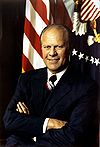
Secretary of the Treasury Secretary of Defense Attorney General Secretary of the Interior Secretary of the Agriculture Secretary of Commerce Secretary of Labor Secretary of Health, Education and Welfare Secretary of Housing and Urban Development Secretary of Transportation Cabinet-level Vice President Ambassador to the United Nations Director of the Office of
Management and BudgetSpecial Representative
for Trade NegotiationsUnited States presidential election, 1988 Republican Party
Convention • Primaries •
Primary resultsNominee: George H.W. Bush
Candidates: Bob Dole · Pete du Pont · Ben Fernandez · Alexander Haig · Jack Kemp · Paul Laxalt · Isabell Masters · Pat Robertson · Donald Rumsfeld · Harold Stassen
VP Nominee: Dan QuayleDemocratic Party
Convention • Primaries •
Primary resultsNominee: Michael Dukakis
Candidates: Douglas Applegate · Bruce Babbitt · Joe Biden (campaign) · David Duke · Dick Gephardt · Al Gore (campaign) · Gary Hart · Jesse Jackson (campaign) · Lyndon LaRouche · Andy Martin · Patricia Schroeder · Paul Simon · James Traficant
VP Nominee: Lloyd BentsenThird party and independent candidates Libertarian Party New Alliance Party Populist Party Prohibition Party Socialist Equality Party Socialist Party USA Socialist Workers Party Nominee: James Warren
VP Nominee: Kathleen MickellsWorkers World Party Independents and other candidates Categories:- 1932 births
- American chief executives
- American Presbyterians
- American people of Swiss descent
- Swiss emigrants to the United States
- Businesspeople in the pharmaceutical industry
- Conservatism in the United States
- George W. Bush Administration cabinet members
- Illinois Republicans
- Gilead Sciences
- Living people
- Members of the United States House of Representatives from Illinois
- United States naval aviators
- New Trier High School alumni
- People from Evanston, Illinois
- People from Winnetka, Illinois
- Presidential Medal of Freedom recipients
- Princeton University alumni
- United States Navy officers
- United States presidential candidates, 1988
- United States Secretaries of Defense
- White House Chiefs of Staff
- Permanent Representatives of the United States to NATO
- Distinguished Eagle Scouts
- United States congressional aides
Wikimedia Foundation. 2010.


